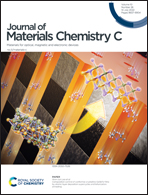A boosting carrier transfer passivation layer for achieving efficient perovskite solar cells†
Abstract
Phenethylammonium iodide and its derivatives have been used to passivate the surface traps of metal halide perovskites films to increase the efficiency of solar cells, but their non-conductive nature harms the hole transfer from the perovskite to hole transport layer (HTL). Here, we prepared a novel solution containing 4-methoxyphenethylammonium iodide (CH3O-PEAI) and 2,3,5,6-tetrafluoro-7,7,8,8-tetracyanoquinodimethane (F4-TCNQ) to address effectively the above issue. CH3O-PEAI passivates the uncoordinated Pb2+ ions of the perovskite film surface. As an electron acceptor, F4-TCNQ can attract electrons from the valence band of the perovskite film. The energy difference between the valence band maximum and the Fermi level of the perovskite is decreased from 1.37 to 1.23 eV, and thus an upward band bending is formed at the perovskite film surface, which facilitates the hole transport from the perovskite to the HTL, and inhibits reverse electron transport. Consequently, the power conversion efficiency of the perovskite solar cells is increased to 21.57%.



 Please wait while we load your content...
Please wait while we load your content...